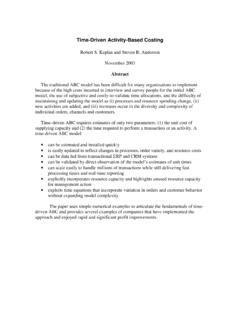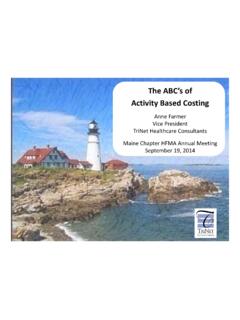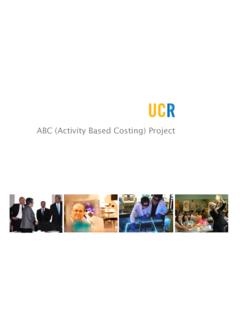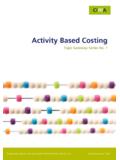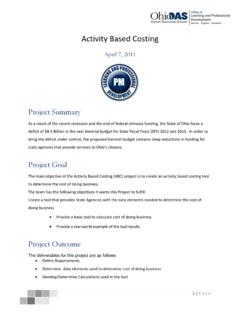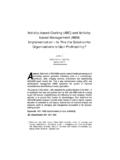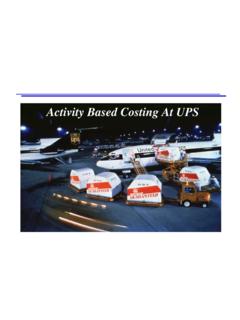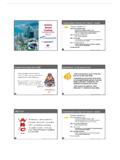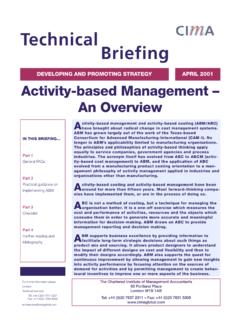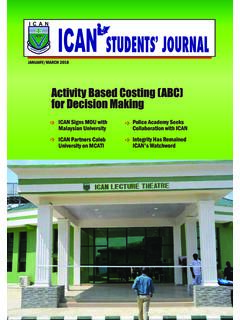Transcription of Activity Based Costing - icmab.org.bd
1 BCAS - 14 BANGLADESHCOST ACCOUNTINGSTANDARDS Activity BasedCostingBCAS 14: Activity Based Costing (ABC) IntroductionIn this ever changing dynamic business environment, managers or decision makers have to identify different ways to focus on business strategy. Cost leadership is one of the important generic startegies that a company can follow to generate the value for the stakeholders. ABC is believed to be the most innovative tool developed in last century in the field of cost and management accounting focusing on product Costing and management strategy. During the late 1980s, Kaplan & Bruns had defined this term in their book.
2 Usually it is treated as the modern alternative to absorption Costing . It enables the business to identify the relevant information in terms of value addition which in turn helps to take more effective decisions for the buisness and society at large. ABC is an approach that identifies the activities that a firm/ organization performs and then assigns indirect costs to products via those activities. This approach or system recognizes the relationship between costs, activities and products, and through this relationship, it assigns indirect costs to products less arbitrarily than traditional methods. ABC focuses attention on cost drivers, the activities that cause costs to increase.
3 Traditional absorption Costing tends to focus on volume related drivers, such as labor hours or machine hours, while Activity - Based Costing uses a varieties of drivers by understanding the causal relationship. In this way, long-term variable overheads, traditionally considered fixed costs, can be traced to products more scientifically. This standard provides guidelines on the applicability of ABC and other peripheral issues surrounding the use of ABC which will change the role of Management Accountant from scorekeeper to Strategic ObjectivesThe main objective of this standard is to provide guidelines to organizations so that cost can be scientifically traced with the cost objects benefiting all the counterparties being affected by misleading allocation.
4 It can be used to identify areas that would benefit from process Costing provides a more accurate method of product/service Costing , leading to more accurate pricing decisions. It increases understanding of overheads and cost drivers and makes costly and non-value adding activities more visible, allowing managers to reduce or eliminate them. ABC enables effective challenge of operating costs to find better ways of allocating and eliminating overheads. It also enables improved product and customer profitability analysis. It supports performance management techniques such as continuous improvement and This standard provides guidelines to trace indirect cost with cost objects more More specifically, the standard addresses the following pertinent issues relating to cost allocation - a) Identifying different activities b) Analyzing activities c) Selecting appropriate cost pools and cost drivers d) Differentiating resource drivers and Activity drivers e) Proposing a cost allocation systemBCAS 14.
5 Activity Based Costing (ABC) This standard may be followed by companies and other business or non-business organizations where cost and management accounting is in practice either as a statutory obligation or to support management decision making Key FeaturesThe key features of this standard are pointed below - a) Presenting the concept of Activity Based Costing as a part of strategic managerial decision; b) It focuses on allocation of indirect cost only; c) It relates with internal decision making perspective which in turn helps all stakeholders; d) Identifying different cost pool and driver which are related to goods or services; and e) Accumulating all relevant cost to the particular goods or services.
6 DefinitionsThe following terms are used in this standard with the meanings specified Activity Based Costing : Activity - Based Costing (ABC) is an accounting method that identifies the activities that a firm performs and then assigns indirect costs to cost Indirect Cost: As defined in BCAS Activity : As defined in BCAS Activity Cost pool: As defined in BCAS Activity Cost Driver: As defined in BCAS Cost Object: As defined in BCAS Cost Hierarchy: The cost hierarchy is a classification system used in Activity - Based Costing that designates activities Based on how easily they can be traced to a Unit Level Activities: These activities are performed each time a unit is Batch Level Activities: Batch level activities are performed each time a batch is handled or processed, regardless of how many units are in the Product Level Activities: These activities are related to specific products and typically must be carried out regardless of how many batches are run or units of product are produced or Customer Level Activities.
7 These activities are related to specific customers and include activities such as sales calls, catalogue mailings and general technical support that are not tied to any specific Organization Sustaining Activities: Theses activities are carried out regardless of which customers are served, which products are produced, how many batches are run, or how many units are 14: Activity Based Costing (ABC) Under ABC, activities in an organization are identified, costs are accumulated with reference to each identified activities and the cost of each Activity is assigned to all products and services according to their respective consumption.
8 Charging direct material and direct labor costs are the same under both traditional cost accounting method and ABC This standard acknowledges that ABC results more pragmatic cost per unit to support strategic management Factors to be considered for implementation of ABC are - a) The commitment of top level management; b) Level of competition; c) Severity of product cost cross-subsidization; d) Varieties of product lines and stock keeping units; and e) Benefits of implementing ABC outweigh the Traditional Costing runs under the principle that 'products consume resources'. However, ABC believes that 'activities consume resources and products are the outcome of activities'.
9 The successful implementation of ABC depends on the identification of different steps in applying ABC along with adherence to the steps. The steps are - a) Identification of major activities involved in the production process; b) Classification of each Activity according to the cost hierarchy; c) Identification and accumulation of total costs of each Activity ; d) Identification of the most appropriate cost driver for each Activity ; e) Calculation of total units of the cost driver relevant to each Activity ; f) Calculation of the Activity rate the cost of each Activity per unit of its relevant cost driver; g) Application of the cost of each Activity to products Based on its Activity usage by the A rational number of activities need to be identified to make the system cost effective.
10 Otherwise more number of activities will make the system chaotic and will make the method difficult to implement. However, there is no standard for fixing rational number of activities. All the identified activities should be categorized as per cost hierarchy. There are four such categories, (a) unit level, (b) batch level, (c) product level, and (d) facility level. Unit level activities are activities that are performed on each unit of product. Batch level activities are activities that are performed whenever a batch of the product is produced. Costs at the batch level depend on the number of batches processes rather than on the number of units produced, number of units sold or other measures of volumes.
